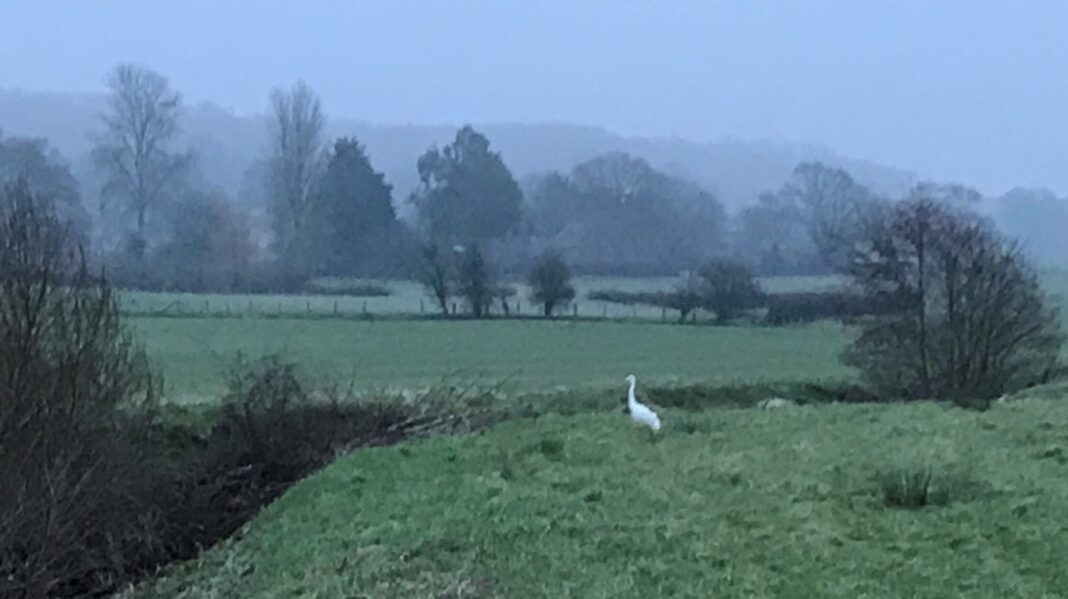Yes I agree, the photograph I’ve used in this article is not the best I’ve ever taken but given the circumstances it was the best I could manage.
While driving from Udimore Road along Hundred House Lane in rural Peasmarsh, something in the distance caught my eye. At first I thought it was a swan, after all they are pretty common in the area so no surprise if it was but then, as I got closer I began to wonder what it really was, as it certainly wasn’t a swan.
My eyes weren’t deceiving me and before you say the words “You should have gone to Specsavers” ( I went recently and was wearing my new glasses at the time), I saw this unusual sight.
It resembled a crane, also pretty common in this area, but it didn’t have the large bill so I concluded it could be a stork but, it was pure white. I quickly took the photo above, on my phone through the car window but unfortunately I had to move as there was a car coming towards me, hence the poor quality photo.
When I got home I started digging around online to find out more and I discovered that after 608 years, white storks are nesting in Britain again. An article from a 2020 issue of National Geographic contained the following:
“High in an oak tree in the county of West Sussex, in south-eastern England, a pair of free-flying white storks hatched three chicks. It was May 6, 2020, a landmark moment: it had been 606 years since the previous written record of white storks breeding anywhere in Britain. Two weeks after those first chicks emerged at Knepp Estate, another pair of storks, in another shaggy nest of sticks in a nearby oak, hatched three more.
“This achievement is beyond thrilling. We dreamed of this moment, and now the storks have done it—we have British-born chicks again!” says Tim Mackrill, a reintroduction expert with the White Stork Project. Launched in 2016, the project aims to establish 50 breeding pairs of white storks in southern Britain by 2030.
“In 2016, the government-approved White Stork Project chose Knepp as its starter site. The project is a partnership among three private landowners and the Durrell Wildlife Conservation Trust, an international charity founded by writer Gerald Durrell to save species from extinction; the Roy Dennis Wildlife Foundation, experts in bird reintroductions across Europe; and Cotswold Wildlife Park, a privately owned zoo in Oxfordshire.
“Knepp’s biodiverse wetlands and grasslands and open-grown trees for nesting are perfect habitat for storks. Two other locations—Wadhurst Park Estate, in East Sussex, and Wintershall Estate, in Surrey—were identified for establishing supplementary release pens the following year.”
There is significant evidence to show that white storks were once a breeding bird of Britain, with an archaeological record stretching back 360,000 years. White storks are particularly associated with the county of Sussex. The Saxon name for the village of Storrington, near Worthing, was originally “Estorchestone”, meaning “the village of the storks”. A pair of white storks still feature on the village emblem. Other place names in the area, such as Storwood and Storgelond, evoke the historical presence of the birds here.
I have no idea what it was that I saw. I would like to think it was a white stork but who knows, time wasn’t on my side and when I looked back to try and take another photo, sadly ‘it’ had gone. I drive that way regularly so hopefully I’ll get the chance to get a better image but if you recognise this bird perhaps you could let me know?
Image Credits: Nick Forman .




This probably a Great Egret.
Little Egrets have been around for quite a while now, and I can confirm there has been sightings of a Great Egret around the Rother valley In Iden and surrounding areas of Rye.
I tend to agree with my namesake. It could well be a Great Egret. They are very big birds, especially when they stretch their necks out, and they are all white with yellow beaks and black legs. There are lots of them on the lakes up at Dungeness. Not seen a white stork but from photos they seem to have red beaks and pink legs. They also have black feathers on their rumps and lower half of their wing feathers. Hope that helps a bit.
Dear Nick, this is, as Ian & Ian have already confirmed, a Great White Egret, a relatively recent colonist of this country. Cranes are not at all common in this area; I suspect you are thinking of Grey Herons, hundreds of which nest in Winchelsea. If you’d like some help in distinguishing these conspicuous and elegant birds, please get in touch with Rye Harbour Nature Reserve where we can also show you Little Egret, Spoonbill and, with luck, Bittern.
The number of Great White Egrets has increased significantly. Recently I saw 3 on Pett Level.
The picture taken of the one off Hundredhouse Lane is looking towards Hayes Lane and is in Beckley not Peasmarsh!